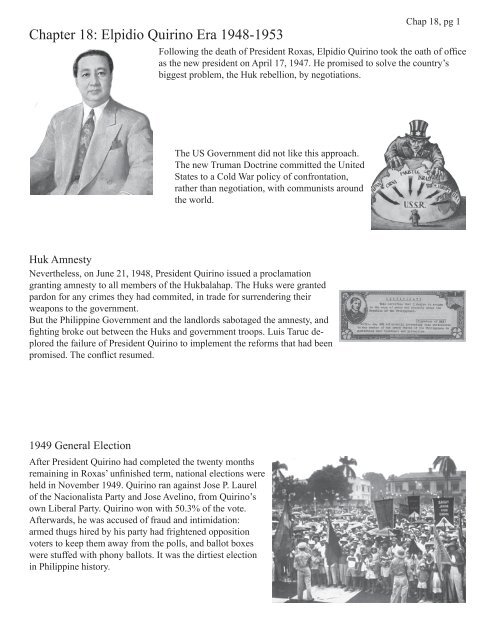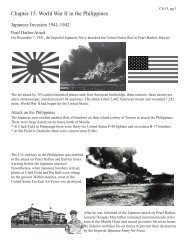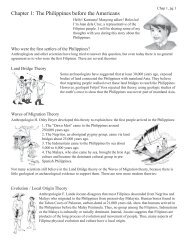Chapter 18: Elpidio Quirino Era 1948-1953 - Chris Pforr Homepage
Chapter 18: Elpidio Quirino Era 1948-1953 - Chris Pforr Homepage
Chapter 18: Elpidio Quirino Era 1948-1953 - Chris Pforr Homepage
You also want an ePaper? Increase the reach of your titles
YUMPU automatically turns print PDFs into web optimized ePapers that Google loves.
<strong>Chapter</strong> <strong>18</strong>: <strong>Elpidio</strong> <strong>Quirino</strong> <strong>Era</strong> <strong>1948</strong>-<strong>1953</strong><br />
Chap <strong>18</strong>, pg 1<br />
Following the death of President Roxas, <strong>Elpidio</strong> <strong>Quirino</strong> took the oath of office<br />
as the new president on April 17, 1947. He promised to solve the country’s<br />
biggest problem, the Huk rebellion, by negotiations.<br />
The US Government did not like this approach.<br />
The new Truman Doctrine committed the United<br />
States to a Cold War policy of confrontation,<br />
rather than negotiation, with communists around<br />
the world.<br />
Huk Amnesty<br />
Nevertheless, on June 21, <strong>1948</strong>, President <strong>Quirino</strong> issued a proclamation<br />
granting amnesty to all members of the Hukbalahap. The Huks were granted<br />
pardon for any crimes they had commited, in trade for surrendering their<br />
weapons to the government.<br />
But the Philippine Government and the landlords sabotaged the amnesty, and<br />
fighting broke out between the Huks and government troops. Luis Taruc deplored<br />
the failure of President <strong>Quirino</strong> to implement the reforms that had been<br />
promised. The conflict resumed.<br />
1949 General Election<br />
After President <strong>Quirino</strong> had completed the twenty months<br />
remaining in Roxas’ unfinished term, national elections were<br />
held in November 1949. <strong>Quirino</strong> ran against Jose P. Laurel<br />
of the Nacionalista Party and Jose Avelino, from <strong>Quirino</strong>’s<br />
own Liberal Party. <strong>Quirino</strong> won with 50.3% of the vote.<br />
Afterwards, he was accused of fraud and intimidation:<br />
armed thugs hired by his party had frightened opposition<br />
voters to keep them away from the polls, and ballot boxes<br />
were stuffed with phony ballots. It was the dirtiest election<br />
in Philippine history.
The Cold War comes to Asia and the Philippines<br />
Until 1949, the Cold War between the United States and the Soviet Union was<br />
focused on Europe, far from the Philippines. But in October 1949, the Chinese Civil<br />
War came to an end when the the communists won and China became the People’s<br />
Republic of China. The United States now had two big communist enemies: The<br />
Soviet Union and China. The U.S. began a policy of “containment” to prevent the<br />
emergence of other communist regimes. The American bases in the Philippines now<br />
became very important.<br />
Chap <strong>18</strong>, pg 2<br />
1949 Mutual Defense Assistance Act<br />
In 1949 the U.S. Congress passed the Mutual Defense Assistance Act, promising defense<br />
assistance to any ally that might be attacked by the Soviet Union. The bill gave millions of<br />
dollars in military aid to the Philippines.<br />
Two Disturbing Reports<br />
1. Bell Mission<br />
In 1950, US President Truman sent a mission headed by Daniel Bell to evaluate the<br />
economic development of the Philippines. The team reported:<br />
“the profits of businessmen and the incomes of large landowners have risen very considerably<br />
[but] the standard of living of most people is lower than before the war.”<br />
And: “the <strong>Quirino</strong> Government was in such a critical condition that only the most<br />
far-reaching program of reform and self-help, supported by technical and economic<br />
assistance from this country, could save the Philippines from total collapse.”<br />
The U.S. Government was worried that increasing poverty could lead to a revolution<br />
like China’s, with the obedient Philippine government being replaced by a communist<br />
government antagonistic to the United States. The investigating team recommended<br />
drastic reforms.<br />
However, the authority of the Philippine government rested on approval from the<br />
wealthy elites, and they blocked reform.<br />
2. U.S. National Security Council Report<br />
Meanwhile, a top-secret 1950 U.S. National Security Council report similarly concluded:<br />
“Inequalities in the Philippines, always large, have become greater during the past few years<br />
while the standard of living of the mass of people has not reached the pre-war level. The<br />
profits of businessmen and the incomes of large land owners have risen considerably. The<br />
deterioration of the economic system has caused a widespread feeling of disillusionment.”<br />
Furthermore, the report continued, “The communist-led Huk movement has taken advantage<br />
of the deteriorating economic situation and exploited the antagonistic attitudes of the people<br />
toward the government in order to incite lawlessness and disorder.... The extent and manner<br />
in which the necessary influence is brought to bear on the Philippine Government to accomplish<br />
essential reforms presents to the U.S. Government a most difficult and delicate problem.<br />
Extreme care must therefore be exercised in the methods used to persuade the Philippine<br />
Government to take the necessary action, to do nothing would result in disaster.”<br />
How would the U.S. Government react?
Chap <strong>18</strong>, pg 3<br />
A Dilemma for the United States<br />
In 1950 the US Government found itself in a difficult position:<br />
To successfully wage the Cold War against the Soviet Union and Communist China, the U.S. needed its military<br />
bases in the Philippines in order to project military power throughout East Asia. So, it needed a stable and loyal<br />
Philippine government. However, the Philippine government in 1950 appeared unstable, and the U.S. feared<br />
that it might be overthrown by the Hukbalahap, who might establish a hostile regime which would cancel the<br />
American base leases and send the U.S. military home. To prevent this, the U.S. knew that popular support for<br />
the Huks could be reduced if economic and social reforms were made.<br />
But the Philippine economic elite were opposed to any changes which might compromise their economic and<br />
political control. Yet if reforms were not implemented, it increased the likelihood of a popular revolution. Would<br />
should the United States Government do?<br />
Rather than viewing the Huks as a legitimate rebellion of poor farmers who just wanted land and a chance to<br />
escape poverty by their own labor, American strategists chose to view them through the prism of the Cold War:<br />
the Huks were a local outbreak of the virus of global Communism who needed to be stamped out. Rather than<br />
trying to eliminate the cause of the rebellion by pushing the Philippine elites to implement reforms, the U.S.<br />
Government settled on a military solution to the problem: crush the Huks.<br />
Central Intelligence Agency (CIA)<br />
The Central Intelligence Agency is part of the United States Government, established in 1947<br />
to provide accurate information to government policymakers. In <strong>1948</strong> the CIA’s charter was<br />
expanded to include covert (secret) operational activities. These secret duties were run by the<br />
Office of Policy Coordination (OPC.) In 1950 the U.S. decided to use OPC against the Huks.<br />
Frank Wisner was the director of the<br />
Office of Policy Coordination.<br />
One of his CIA deputies was Lieutenant<br />
Colonel Edward Lansdale, an Air Force<br />
“psy-war” (psychological warfare) expert.<br />
Early in 1950, a delegation of Philippine legislators went to Washington D.C., to lobby for<br />
passage of the Rogers Bill, which would provide benefits to Filipino war veterans. One of<br />
the delegates was a Congressman named Ramon Magsaysay. In Washington, he met Colonel<br />
Lansdale, who introduced him to his boss Frank Wisner. Both Americans were impressed<br />
with the young Philippine Congressman.<br />
Since the CIA had been assigned the task of destroying the Hukbalahap insurgency, Frank Wisner<br />
offered Magsaysay a deal: the CIA would provide undercover support for Magsaysay’s political career if he<br />
would act as America’s surrogate.<br />
When Magsaysay returned to the Philippines, the U.S. State Department and the JUSMAG (Joint United States<br />
Military Assistance Group) pressured President <strong>Quirino</strong> to appoint Magsaysay as Secretary of National Defense,<br />
which he did. The CIA then had Colonel Lansdale assigned to the JUSMAG, to assist the Armed Forces of the<br />
Philippines against the Huks. The stage was set.
War against the Huks<br />
The Hukbalahap guerrillas, who had fought the Japanese during World War II,<br />
were mostly illiterate, landless farmers who just wanted their own plots of land.<br />
But the counterinsurgency campaign devised by Lansdale and Magsaysay portrayed<br />
them as dangerous Communists directed by the evil Russians.<br />
There were several parts of the new counterinsurgency strategy:<br />
Chap <strong>18</strong>, pg 4<br />
In 1950 Colonel Lansdale arrived in the Philippines to work with the new<br />
Defense Minister, Ramon Magsaysay, to create a military counter-insurgency<br />
operation against the Huks. The two worked closely, Lansdale providing the<br />
innovative ideas and unconventional methods and Magsaysay issuing the<br />
official orders.<br />
1. Conventional military operations<br />
The Philippine Constabulary was merged with the Armed Forces of the Philippines and<br />
expanded, then given new guns, vehicles, and a small air force by the US. They aggressively<br />
pursued the Huks and offered cash rewards to any soldier who killed a guerrilla.<br />
2. Psychological Warfare<br />
A new Civil Affairs Office (CAO) was set up to create anti-Huk propaganda. This was<br />
Lansdale’s specialty, and he supervised the production and distribution of millions of<br />
anti-Huk leaflets, the making of movies and books, organization of anti-communist<br />
rallies in colleges and grade schools, hiring of spies to infiltrate the Huks, and waging<br />
of a disinformation campaign by spreading lies about the Huk leadership.<br />
3. Dirty tricks campaign<br />
Of many new techniques used, one became famous: Lansdale decided to apply<br />
some psyops (psychological operations) to displace Huk guerrillas who were<br />
hiding out in a mountain region. First local intelligence agents planted stories in<br />
the community about asuang (vampires) living in the hills. Then Constabulary<br />
soldiers set up an ambush along a Huk trail. When a Huk patrol came by, the<br />
troops let them pass, except for the last man, whom they grabbed. After killing<br />
him, they made two small holes in his neck and then hung him upside down and<br />
allowed all his blood to drain out. The body was left on the trail for the Huks to<br />
find when they came back looking for him. The Huk unit vanished into thin air<br />
the next day, leaving the mountain to the government troops.<br />
A Great Success<br />
The Anti-Huk campaign was one of the most successful anti-guerrilla wars in modern history. It pleased the<br />
Philippine landholding elite who feared losing their big estates to the poor peasants. The U.S. was relieved<br />
because survival of the <strong>Quirino</strong> Government assured the crucial military bases would stay in American hands.<br />
The strategy became the model for future American counterinsurgency wars in Vietnam and Latin America.
1950 Philippine Expeditionary Force to Korea (PEFTOK)<br />
At the urging of the United States, the Philippines sent an<br />
expeditionary force of 7,500 combat troops to fight in the<br />
Korean War in August 1950. The Philippine units were armed<br />
and supplied by the United States and fought under the<br />
command of U.S. General Douglas MacArthur as part of a<br />
United Nations multinational force. Filipinos losses included<br />
110 soldiers killed in action and an additional 300 wounded,<br />
before all the Filipino soldiers were brought home in 1955.<br />
1951 Mutual Defense Treaty<br />
<strong>1953</strong> Philippine Presidential Election<br />
Chap <strong>18</strong>, pg 5<br />
In 1951 the Philippines and the United States signed and ratified the<br />
Mutual Defense Treaty. The overall accord contained eight articles and<br />
dictated that both nations would support each other if either the<br />
Philippines or the United States were to be attacked by an external<br />
party.<br />
In the <strong>1953</strong> Philippine election, President <strong>Quirino</strong> ran<br />
against Defense Minister Magsaysay, who had become very<br />
popular due to his exploits against the Huks.<br />
The U.S. Central Intelligence Agency helped to funnel funds<br />
from American business interests to Magsaysay’s campaign,<br />
and he won with 68% of the vote to become the new<br />
Philippine President.





